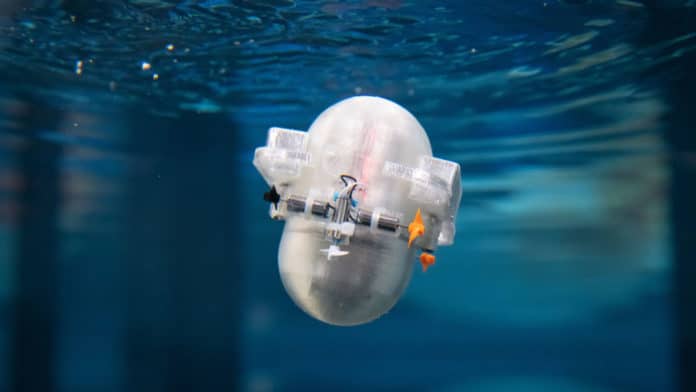Navigation in the presence of a background unsteady flow field is an important task in a wide range of robotic applications, including ocean surveying, monitoring of deep-sea animal communities, drone-based inspection, and delivery in windy conditions. In such applications, robots may only have knowledge of their immediate surroundings or be faced with time-varying currents, which limits the use of optimal control techniques.
Engineers at Caltech, ETH Zurich, and Harvard are developing artificial intelligence (AI) that will allow autonomous drones to use ocean currents to aid their navigation rather than fighting their way through them.
The team tested the AI’s performance using computer simulations and also developed the CARL-Bot (Caltech Autonomous Reinforcement Learning Robot), a small palm-sized robot that looks like a cross between a pill capsule and a dumbo octopus. It runs the algorithm on a tiny computer chip that could power seaborne drones both on Earth and other planets.
The CARL-Bot has motors for swimming around, is weighted to stay upright, and has sensors that can detect pressure, depth, acceleration, and orientation. The goal is to create an autonomous system to monitor the condition of the planet’s oceans. The robots running the algorithm could even explore oceans on other worlds, such as Enceladus or Europa.
In either scenario, drones would need to be able to make decisions on their own about where to go and the most efficient way to get there. To do this, researchers turned to reinforcement learning (RL) networks. The team wrote software that can be installed and run on a Teensy – a 2.4-by-0.7-inch microcontroller that only uses about a half-watt of power.
The AI algorithms for CARL-Bot could teach it to orient itself based on changes in its immediate environment and past experiences. CARL-Bot can decide to adjust its route on the fly to maneuver around the rough currents and get to its destination.
The AI would have access to information that could be gathered from an onboard gyroscope and accelerometer, which are both relatively small and low-cost sensors for a robotic platform. This kind of navigation is analogous to the way eagles and hawks ride thermals in the air, extracting energy from air currents to maneuver to the desired location with the minimum energy expended. Surprisingly, the researchers discovered that their reinforcement learning algorithm could learn navigation strategies that are even more effective than those thought to be used by real fish in the ocean.
The team plans to test the AI on each different type of flow disturbance it would possibly encounter on a mission in the ocean to assess its effectiveness in the wild. The team is placing the Teensy on a custom-built drone, the CARL-Bot. The CARL-Bot will be dropped into a newly constructed two-story-tall water tank on Caltech’s campus and taught to navigate the ocean’s currents.
“Not only will the robot be learning, but we’ll be learning about ocean currents and how to navigate through them,” says Peter Gunnarson, a graduate student at Caltech and lead author of the paper.
